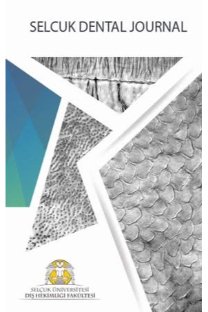Dilaceration of maxillary incisors: Two case reports
Maksiller kesici dişlerin dilaserasyonu: 2 olgu sunumu
___
- 1. Arx T. Developmentaldisturbances of permanent teethfollowing trauma to the primary dentition. J Aust Dent 1993; 38:1-10
- 2. Santo Jácomo DR, Campos V. Prevalence of sequelae in the permanent anterior teeth after trauma in their predecessors: a longitudinalstudy of 8 years. Dent Traumatol 2009;25:300-4
- 3. Crescini A, Doldo T. Dilaceration and angulation in upperincisors consequent to dental injuries in the primary dentition: orthodontic management. Prog Orthod 2002;3:29- 41
- 4. Assunção L, Ferelle A. Effects on permanent theeth afterluxation injuries to the primary predecessors: a study in children assisted at an emergency service. Dent Traumatol 2009; 25:165-9
- 5. Topouz elis N, Tsaousoglou P, Gofa A. Management of root dilaceration of an impacted maxillary central incisor following orthodontic treatment: an unusual therapeutic outcome. Dent Traumatol 2010;26: 521-6
- 6. Topouzelis N, Tsaousoglou P, Pisoka V, Zouloumis L. Dilaceration of maxillary central incisor: a literature review. Dent Traumatol. 2010;26:427-33
- 7. Colak I, Markovic D, Petrovic B, Peric T, Milenkovic A. A retrospective study of intrusive injuries in primary dentition. Dent Traumatol 2009;25:605–10.
- 8. Karabulut DCC, Er F, Orhan K, Solak H, Karabulut B, Aksoy S, Cengiz E, Basmacı F, Aksoy U. Kuzey Kıbrıs Türk Cumhuriyetinde dişhekimliği fakültesine başvuran yetişkin popülasyonda diş gelişim bozukluklarına sahip bireylerin oranı. Gülhane Tıp Dergisi 2011;53:154-161.
- 9. Sönmez IŞ, Nalçacı R, Oba AA. Süt dişi intrüzyonuna bağlı daimi dişlerde ortaya çıkan gelişimsel anomaliler. Hacettepe Diş Hekimliği Fakültesi Dergisi 2007;3:24-27.
- 10. Hamasha AA, Al-Khateeb T, Darwazeh A. Prevalence of dilaceration in Jordanian adults. Int Endod J 2002;35:910– 2.
- 11. Frank CA. Treatment options for impacted teeth. J Am Dent Assoc 2000;131:623–32.
- 12. McNamara T, Woolfe SN, McNamara CM. Orthodonticmanagement of a dilacerated maxillary central incisor with an unusual sequel. J Clin Orthod 1998;32:293–7.
- 13. Singh GP, Sharma VP. Eruption of an impact edmaxillary central incisor with an unusual dilaceration. J Clin Orthod 2006;40:353–6.
- 14. Kuvvetli SS, Seymen F, Gencay K. Management of an unerupted dilacerated maxillary central incisor: a case report. Dent Traumatol 2007;23:257–61.
- 15. Valladares Neto J, de Pinho Costa S, Estrela C. Orthodontic– surgical–endodontic management of unerupted maxillary central incisor with distoangular root dilaceration. J Endod 2010;36:755–9.
- 16. Farronato G, Maspero C, Farronato D. Orthodontic movement of a dilacerated maxillary incisor in mixed dentitiontreatment. Dent Traumatol 2009;25:451–6.
- 17. Smith DMH, Winter GB. Root dilaceration of maxillary incisors. Br Dent J 1981;150:125–7.
- 18. Stewart DJ. Dilacerate unerupted maxillary central incisors. Br Dent J 1978;145:229–33.
- 19. Witherspoon DE, Ham K. One-visit apexification: technique for inducing rootend barrier formation in apical closures. Pract Proced Aesthetic Dent 2001;13:455-60.
- 20. Guilinai V, Bacetti T, Pace R, Pagavino G. Theuse of MTA in teeth with necrotic pulps and openapices. Dent Traumatol 2002;18:217-21.
- 21. Rafter M. Apexification: a review. Dent Traumatol 2005; 21:1-8.
- 22. Island G, White GE. Polyethelene ribbond fibers: a new alternate for restoring badly destroyed primary incisors. J Clin Pediatr Dent 2005;29:151-6.
- 23. Xuan K, Zhang Y, Liu Y, Fang J, Ke-wen W. Comprehensive and sequential management of an impacted maxillary central incisor with severe crown–root dilacerations. Dental Traumatology 2010;26:516–520
- ISSN: 1300-5170
- Yayın Aralığı: Yılda 3 Sayı
- Başlangıç: 1991
- Yayıncı: İsmail Marakoğlu
Dilaceration of maxillary incisors: Two case reports
Mustafa ALTUNSOY, EMRE KORKUT, Murat Selim BOTSALI, Gül TOSUN
Tek kon yönteminin apikal sızıntıyı engelleme yeteneğinin 3 farklı
Erhan ÖZCAN, İsmail Davut ÇAPAR, Özlem KOYDUK KAHVECİ, Hale ARI
Fiber ile güçlendirilmiş kompozit (FRC) post yüzeyine rezin
Betül ÖZÇOPUR, Andaç Barkın BAVBEK, KEZBAN ÇELİK, Meltem ÖZER, Gürcan ESKİTAŞCIOĞLU
Third molar agenesis in hypodontia patients
A. Pınar SÜMER, Kaan GÜNDÜZ, Soner ÇANKAYA
Farklı kök güçlendirme yöntemleri ile restore edilmiş immatür
MELEK AKMAN, Sema BELLİ, Özlem DOYDUK KAHVECİ, Ayçe ELDENİZ ÜNVERDİ
Conservative treatment of dentigerous cysts in children: A case report
Gülsüm YILDIRIM, Ayşe SELÇUK, Gül TOSUN, Celal IRGIN, Doğan DOLANMAZ
Hızlandırılmış yaşlandırma sonrası kompozit rezin simanların
Nuri Murat ERSOY, Bülent KESİM
Ceyhun ARICIOĞLU, Hanife ATAOĞLU
İki farklı; fiberle güçlendirilmiş inley köprü sisteminin kırılma
Comparative efficacy of butamben, iodoform, eugenol mixture
Gülsüm YILDIRIM, Celal ÇANDIRLI, Dilek MENZİLETOĞLU KIZILOĞLU, Ahmet MİHMANLI, Doğan DOLANMAZ
